
From Flickr CC // flic.kr/p/dksV5a
Do Immigrants Have More Conservative Sexual Attitudes Than Other College Students?
Sociologists have long been interested in immigrant assimilation. They have usually focused on how well immigrants are able to learn English, earn educational degrees, find jobs, and achieve the American Dream economically. In a recent blog post, we took another angle, considering how the sexual behavior of college students differs by immigrant status. Our results (here) showed that, within most racial-ethnic groups, immigrants are generally more conservative in their sexual behavior during college than are non-immigrants.
Whereas our previous post focused on sexual behavior, in this post, we examine how college students’ attitudes about sex vary by immigrant status. Specifically, we examine attitudes about whether sex before marriage is wrong, love is necessary to have sex, sex between partners of the same sex is wrong, and men and women who have had many sexual partners are disrespected.
Our Method of Investigating Effects of Immigrant Status on Sexual Attitudes
We use data from the Online College Social Life Survey (OCSLS), a survey of over 20,000 students at four-year colleges or universities in the United States. To examine how student attitudes vary by immigrant status, we divide students into three groups:
- First-generation immigrants are students who were not born in the U.S.
- Second-generation immigrants are students whose mother or father, or both, was not born in the U.S., but students themselves were.
- “Non-immigrants” are students born in the U.S. and whose parents were also born in the U.S., so their families have been in the U.S. for at least three generations.
The graphs below (click to expand all images) compare these three groups, giving the percentage of each group that has a particular sexual attitude on each of the five survey questions of interest. These percents have been regression-adjusted to adjust out any part of the immigrant group differences that result from students’ ages the education of their mothers (as an indicator of social class background).
One reason to think that immigrants would have more conservative sexual attitudes is that they or their parents may originate from, and thus were socialized in, countries that have more conservative sexual cultures than the U.S. Thus, our hypothesis was that first-generation immigrants would have the most restrictive attitudes about sex, followed by second-generation immigrants, and non-immigrants would have the most permissive attitudes. The idea is that first-generation and, to a lesser extent, second-generation immigrants retain some cultural views from the country their parents grew up in due to the influence of their parents or the immigrant social networks from this country they may associate with. On the other hand, if the countries from which immigrants come have as or more liberal sexual cultures than does the U.S., we would not find these differences.
We show comparisons of the three immigrant status groups separately for four racial-ethnic groups: Blacks, East Asians, Hispanics, and Whites. We did this because our previous post on sexual behaviors (here) found few differences by immigrant status for Whites, perhaps because the societies from which White immigrants typically come (Canada, Europe, and Australia) are not more conservative sexually than the U.S.; we will show a similar pattern here on most items. We also provide comparisons for men and women separately.
For more details on our methodology and tables with complete results, see the Technical Appendix at the end of this post. Note that, in all the graphs, a star above a bar indicates that the difference between this immigrant group’s percent and the percent for non-immigrants of that racial/ethnic group are statistically significant.
Who Thinks Sex Before Marriage Is Wrong?
To investigate students’ views of premarital sex, we used a survey question that read: There’s been a lot of discussion about the way morals and attitudes about sex are changing in this country. If a man and a woman have sex relations before marriage, do you think it is always wrong, almost always wrong, wrong only sometimes, or not wrong at all. We considered those who gave any of the first three responses to think it is wrong.
Premarital sex is ubiquitous in the U.S. and most affluent Western nations. Consistent with this, the graphs below (click to expand) show that a low percent of White students, never as many as 35%, believe it is wrong. Moreover, first-generation White immigrants have no more conservative attitudes than non-immigrants, which suggests that the other Western nations from which most white immigrants hail are similar to the U.S. in beliefs on this.
It is among East Asian and Hispanic women (although only statistically significant for the latter) and East Asian men (where it is statistically significant) that we see the expected “downward stair-step” pattern, with first-generation immigrants most likely to believe sex before marriage is wrong, followed by second-generation immigrants, then non-immigrants. The group most likely to believe sex before marriage is wrong among either men or women is Black first-generation immigrants (and the first-generation versus non-immigrant contrast is statistically significant for women).
Who Thinks Love Is Necessary for Sex ?
Less stringent than believing sex is only okay if you’re married is the belief that sex should be confined to relationships involving love. To get at this, the survey asked students to rate their agreement with the statement: I would not have sex with someone unless I was in love with them. Responses included strongly agree, agree, disagree, and strongly disagree; we considered those who strongly agreed or agreed to have the more restrictive responses. In this era of “hooking up,” readers may be surprised that in every group (by race/ethnicity and immigrant status) over 40% of women agreed with that statement.
As for whether immigrants are distinctive, the graphs below show that among East Asian women and men and Hispanic women we find the expected pattern of statistically significant differences in which first-generation immigrants are the most restrictive, second-generation immigrants the next-most restrictive, and non-immigrants the least so. Among East Asians, the differences are quite large: 71% of first-generation but only 48% of non-immigrant women, and 60% of first-generation but only 30% of non-immigrant men see love as necessary for them to have sex. There is no pattern of immigrants being more conservative among Whites or Blacks of either sex or among Hispanic men.
Who Disrespects Men and Women Who Have Had Many Sexual Partners?
Examining which students look down on those with many sexual partners is another way to gauge group variation in sexual conservatism. While the party or hookup culture would seem to encourage having multiple partners, we saw a diversity of student opinions about whether that’s okay. The survey asked students to respond to the statement: If women hook up or have sex with lots of people, I respect them less. Later in the survey (enough items away to try not to make the comparison obvious) the same question was asked about men. Possible responses were strongly agree, agree, disagree, and strongly disagree; we considered a student to have the restrictive view if they answered either of the first two. As the graphs below show, when women students are judging men, there is no significant difference between the views of immigrants and non-immigrants within any of the race-ethnic groups, and when they are judging women, it is only among East Asian women that first-generation immigrants disrespect those with many partners more than others do.
The third graph below is for male respondents, and shows that immigrants are not significantly different than non-immigrants in how they judge men in any group except Whites, where we see a pattern counter to our hypothesis: among White men, first-generation immigrants are less disrespectful of men with many sexual partners than are non-immigrants.
Where our hypothesis of greater conservatism among immigrants is upheld is for male students is in their judgments of women, shown in the fourth graph below. In every group except Whites–that is, among Blacks, East Asians, and Hispanics–first-generation immigrant male students disrespect women with many partners significantly more than do non-immigrant men. These differences are quite large. Among Blacks, 82% of first-generation immigrants but only 64% of non-immigrants claim this disrespect of women with many partners; the analogous differences for East Asian men’s view of women is 76% (first-generation) versus 58% (non-immigrants), and for Hispanic men’s view of women is 70% (first-generation) versus 49% (non-immigrants). (In each case, the second-generation group is between the other two groups.)
Recall that there was no group of men in which first-generation immigrant men were significantly more condemning of men with many partners than non-immigrant men. Yet we have just seen large immigrant-status differences for Black, East Asian, and Hispanic men in how they judge women who have many partners. Putting these two facts together implies that the difference between their disrespect of men versus women who have many sexual partners is much larger for first-generation immigrants than non-immigrants. (This can be seen easily in Table 2 in the Technical Appendix below.) To put it more simply, the double standard, in which women are judged more harshly than men for casual sex, is more apparent for first-generation immigrants than non-immigrants among Black, East Asian, and Hispanic men.
Who Believes that Sex between Same-Sex Partners Is Wrong?
Acceptance of same-sex couples and their sexual relationships is growing in the U.S., as we showed here, but groups differ in their views. To get at how accepting students are of sex between same-sex partners, the survey asked students to give their Opinion about sexual relations between two adults of the same sex, with responses “always wrong, almost always wrong, sometimes wrong, and not wrong at all.” We considered those who gave any of the first three responses to see it as wrong. As the two graphs below show, among both men and women, first-generation immigrants are more likely to think that homosexuality is wrong than non-immigrants among Blacks, East Asians, and Whites. Among Hispanics, for both men and women, second-generation immigrants are significantly more restrictive than non-immigrants, but the first-generation immigrants are not the most restrictive. Some of the differences are quite large, especially among men; among Blacks, 72% of first-generation men, but only 56% of non-immigrant men see sex between same-sex partners as wrong, and the analogous figures are 61% (first-generation) versus 29% (non-immigrant) among East Asians, and 50% (first-generation) versus 38% (non-immigrant) among Whites. Thus, it appears that immigrants generally come from cultures that are less accepting of same-sex relationships, but opinions liberalize across generations in the U.S.
Conclusion
The general pattern that we have found, with a few exceptions and some nonsignificant differences, is that first-generation immigrants have the most restrictive and conservative sexual attitudes, whereas non-immigrants within the same racial-ethnic group have the most permissive sexual attitudes. Second-generation immigrants often have sexual attitudes that lie in between. This suggests that with each subsequent generation, immigrants become more assimilated to the views common among college students in the U.S. The in-between position of second-generation immigrants illustrates the influences of both the country their parents are from and the country in which they are coming of age.
The pattern of the most liberal attitudes among non-immigrants and most restrictive among first-generation immigrants did not hold for Whites, with one exception: like other groups of women and men, White first-generation immigrant students are more likely to think that sex between same-sex partners is wrong. This heterosexist belief is most prevalent among first-generation immigrants who are Black and East Asian, and, among Hispanics, second-generation immigrants are more intolerant than non-immigrants (but first-generation immigrants aren’t the most restrictive). Across all five attitudes we examined, immigrant status differences are largest and most consistent for East Asians, most of whom come from China, Taiwan, and Vietnam. This stair-step pattern of the most restrictive views being seen among first-generation immigrants and the least among non-immigrants is also found for several of the attitudes for Blacks and Hispanics.
Attitudes revealing a lack of respect for those who have multiple sexual partners suggest that the double standard, in which women are condemned more harshly for casual sex than men, is strongest among first-generation and weakest among non-immigrant men among Blacks, East Asians, and Hispanics.
Technical Appendix: Information on the OCSLS and Our Statistical Procedures
We used data from the Online College Social Life Survey (OCSLS). The OCSLS surveyed over 20,000 students from 21 four-year colleges and universities between 2005 and 2011. The survey had participants answer questions about their experiences with sex, dating, relationships, and hooking up, as well as their sexual attitudes. We dropped students more than 24 years old. The colleges and universities where the survey was administered were both private and public. The majority were a “flagship” state university. In terms of year in school, they were 35% freshmen, 23% sophomores, 20% juniors, and 17% in their fourth or higher year in school.
A limitation of the OCSLS survey is that participants surveyed were not a probability sample. But, because the instructors in the (predominantly sociology) courses hosting the survey gave students extra credit, participation in these classes was nearly 100%. Thus, any non-representativeness of the sample is likely caused by the schools chosen and the kinds of students in the hosting courses not be who decided to participate within classes. Also helpful to the representativeness of the sample is the fact that, although the hosting classes were mostly Sociology, only 10% of respondents were sociology majors.
OCSLS gauged the participant’s immigrant status by asking three questions: whether they were born in the U.S., whether their mother was, and whether their father was.
- Were you born in the United States (one of the 50 states or Washington, DC)?
- Was your mother born in the United States (one of the 50 states or Washington, DC)?
- Was your father born in the United States (one of the 50 states or Washington, DC)?
We considered first-generation immigrants those not born in the United States. Second-generation immigrants are those with a mother or father or both who were not born in the United States. Non-immigrants are those who were born in the United States and have parents who were both also born in the United States.
For each of the attitude items of interest, we dichotomized the response categories, and, estimated logistic regressions predicting the more restrictive response from immigrant status (defined as above), mother’s education, and age. Separate regressions were estimated for four-racial ethnic groups: Blacks, East Asians, Hispanics, and Whites. (South Asians were too few for reliable estimates.) Based on these regression estimates, we computed predicted probabilities of choosing the more restrictive answer for each immigrant-status group within each race-ethnic group, using a procedure that sets the distribution of the two control variables (age and mother’s education) for each immigrant group to match the full sample distribution for their race-ethnic group. Thus, these predicted probabilities can be thought of as simply the adjusted percent of the immigrant group that gave the more conservative response, where any part of the difference that is due to the immigrant-status groups differing in age or mother’s education has been adjusted out. (Note that adjustments for control variables are within, not between race-ethnic groups.) The adjusted probabilities are below in Tables 1 and 2. Note that in the tables below, as well as in all the graphs in this post, a star indicates that the difference between this immigrant group’s (adjusted) percent and the (adjusted) percent for non-immigrants of that racial/ethnic group are statistically significant at the p<.05 level, using two-tailed tests.
Researchers who wish to use the OCSLS data can contact Paula England at pengland@nyu.edu for information on how to download the data.
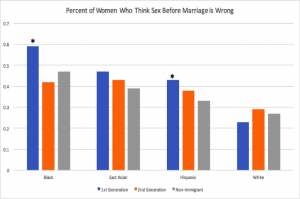
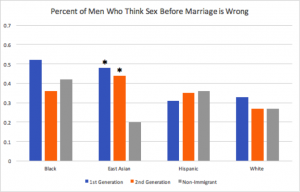
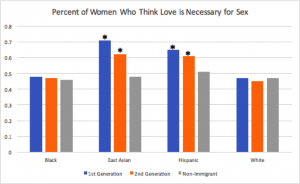
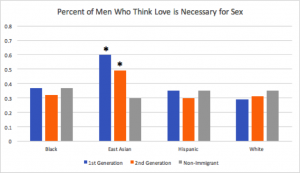
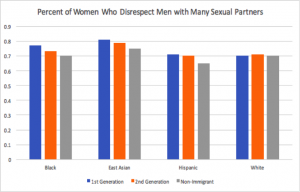
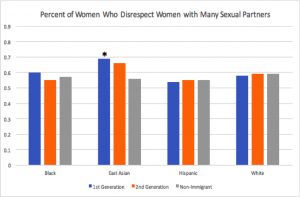



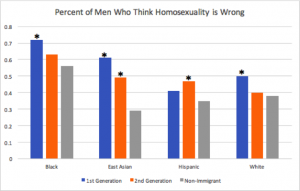
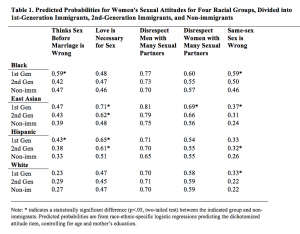


Comments 7
Pharmacy Online
September 14, 2018Previous studies of religiosity have often been limited to proxy measures such as religious service attendance; however, such measures implicitly assume multiple service attendance denotes greater degree of religiosity, without taking into account different customs between religions. Islamic traditions include multiple formal daily prayers, while in contrast, Zen Buddhism does not require followers to attend explicitly defined services on a daily or weekly basis, concentrating more personal convocations and enlightenment ( Welwood,). Devotees of both may feel religion to be a similarly important aspect of their lives, but only the Muslim would register as devout on a proxy measure. To compare religiosity across the heritage religions of multiple ethnic groups, then, one must have a measure of the individual s perceptions of the impact of religion in their life-that is, the individual s
camike
October 1, 2018Your friend's blog I read, I am impressed by your blog, I hope you will have more blogs or more articles to bring to the reader.
wings io
Georgia Amiet
June 11, 2019I do not think this is somehow related to what nationality they are. In college, first of all, all students should be focused on their studies. That is why I want to recommend an educational portal tooly.io, where you will find a lot of useful information for college students, good luck to you.
coca
March 4, 2020The article gave me many good and useful tips. I have gained a lot of experience from your article.
fnaf
Kilpy Mor
April 18, 2020Why ?
Dean
April 22, 2020You know, this is interesting. I was just asked to write an essay on this topic. If anyone is interested in the same way as I am, then you can use this resource 10dollaressay.org
kitchen advisor
September 15, 2020Surprise all your family and friends and acquire https://mykitchenadvisor.com/ right now. Here ?e provide the full range of services right now.